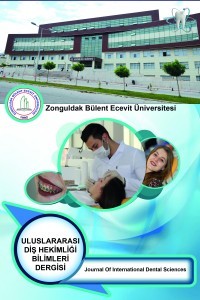Artrosentez Vertigo Tedavisinde Bir Seçenek Olabilir mi?: Olgu Sunumu
Artrosentez, Vertigo, Tinnitus, Redüksiyonsuz Disk Deplasmanı
Is Arthrocentesis a Choice for Treatment of Vertigo: A Case Report
Arthrocentesis, Vertigo, Tinnitus, Disc Displacement Without Reduction.,
___
- 1. Michael M, editor. Jeffrey M. Peterson’s Principles of Oral and Maxillofacial Surgery. 2nd ed. Londra, BC Decker Inc, 2004.
- 2. Stepan L et al. Temporomandibular disorder in otolaryngology: Systematic review. J Laryngol Otol 2017; 131: 50-56.
- 3. Alpaslan G, Alpaslan C. Efficacy of temporomandibular joint arthrocentesis with and without injection of sodium hyaluronate in treatment internal derangements. J. Oral Maxillofac. Surg. 2001; 59: 613-618.
- 4. Bahadır O, Seher GA. Temporomandibular eklem anatomisi ve rahatsızlıkları. Dicle Tıp Dergisi 2008; 35: 77- 85.
- 5. Hilgenberg PB et al. Temporomandibular disorders, otologic symptoms and depression levels in tinnitus patients. J Oral Rehabil 2012; 39: 239-244.
- 6. Neuhauser KH et al. Migrainous vertigo: Prevalence and impact on quality of life. Neurology 2006; 76: 1028-1033.
- 7. Lempert T. et al. Vestibular migraine: Diagnostic criteria. J Vestib Res 2012; 22: 167-172.
- 8. Moon SJ. et al. The effect of postural restrictions in the treatment of benign paroxysmal positional vertigo. Eur Arch Otorhinolaryngol 2005; 262: 408–411.
- 9. Tanrıöver Ö. et al. Birinci basamakta tinitus ile başvuran hastaya yaklaşım. Türk Aile Hek Derg 2011; 15: 24-28.
- 10. Parker WS, Chole RA. Tinnitus, vertigo and temporomandibular disorders. J Orthod Dentofac Orthop 1995; 107: 153-158.
- 11. Ramirez ALM et al. Theories on otic symptoms in temporomandibular disorders: Past and present. Int J Morphol 2005; 23: 141-156.
- 12. Toledo IP, Stefani FM. Prevalence of otologic signs and symptoms in adult patients with temporomandibular disorders: a systematic review and meta-analysis. Clin Oral Invest 2016; 21: 597-605.
- 13. Marchiori LM et al. Probable correlation between temporomandibular dysfunction and vertigo in the elderly. Int Arch Otorhinolaryngol 2014; 18: 49-53.
- 14. Williamson EH. The interrelationship with internal derangements of the temporomandibular joint, headache, vertigo and tinnitus: A survey of 25 patients. The Journal of Craniomandibular Practice 1990; 8: 301-306.
- 15. Rodriguez JF et al. Anatomical considerations on the discomalleolar ligament. J Anat 1998; 192: 617-621.
- 16. Norena AJ. Revisiting the cochlear and central mechanisms of tinnitus and therapeutic approaches. Audiol Neurotol 2015; 20: 53-59.
- 17. Tozoğlu S. et al. Outcome of otologic symptoms after temporomandibular joint arthrocentesis. J Craniofac Surg 2015; 26: 344-347.
- ISSN: 2149-8628
- Yayın Aralığı: Yılda 3 Sayı
- Yayıncı: Zonguldak Bülent Ecevit Üniversitesi
Konik Işınlı Bilgisayarlı Tomografi Uygulamasında Karşılaşılan İlginç Tesadüfi Bulgu
Halil Tolga YÜKSEL, Gökçe YÜKSEL
Artrosentez Vertigo Tedavisinde Bir Seçenek Olabilir mi?: Olgu Sunumu
Cansu Gül KOCA, Gülperi KOÇER, Mert BÜLTE
Farklı Solüsyonlardaki Dört Farklı Akrilik Rezinin Renk Stabilitesi
Hakkı ÇELEBİ, E Begüm BÜYÜKERKMEN, Ceyda AKIN, Ali Rıza TUNÇDEMİR, Recep Sezer YILDIRIM
İrrigasyon Solüsyonlarının Koronal Bariyer Materyallerinin Bağlantı Dayanımına Etkisi
Taha ÖZYÜREK, Hande ÖZYÜREK, Ebru ÖZSEZER DEMİRYÜREK
Protez Yapımı Öncesi Radyografik Değerlendirmenin Önemi: İki Olgu Sunumu
A. Pınar SUMER, Mahmut SUMER, Hazal KARSLIOĞLU, Anar ABİLOV
Çocuklarda ve Adolesanlarda Periodontal Hastalıklar ve Erişkinliğe Etkisi
Simge DURMUŞLAR, Betül AKCABAŞ
Gastroözofagal Reflü Hastalığı Olan Bireylerin Ağız Sağlığı Durumu
Seda CENGİZ, M İnanç CENGİZ, Çağrı URAL, Y Şinasi SARAÇ
Diş Hekimliğinde Konik Işınlı Bilgisayarlı Tomografi Kullanımı: Literatür Taraması
İntrüze Olmuş Maksiller Lateral Dişin Ortodontik Ekstrüzyon ile Tedavisi: Olgu Sunumu
Pelin TÜFENKÇİ, Hakan KURT, Berkan ÇELİKTEN, Nihal AKKAYA, Orhan ÖZDİLER
